Home » Gemstones » Opal » Matrix Opal
Matrix Opal
An intimate mixture of precious opal and host rock.
Author: Hobart M. King, PhD, GIA Graduate Gemologist
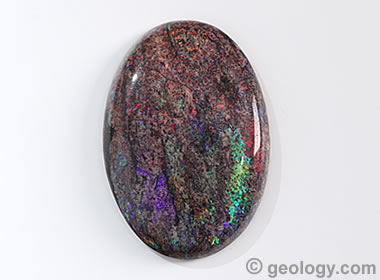
Andamooka Treated Matrix Opal: The cabochon above is an example of a limestone matrix opal from the Andamooka area of Australia. Tiny occurrences of opal are distributed through a light-colored limestone host rock. The host rock is darkened in color by smoke or dye to provide a greater contrast with the opal.
What Is Matrix Opal?
Matrix opal is a gem material in which precious opal (or play-of-color opal) is intimately distributed through its host rock. The precious opal can occur as a "cement" between sediment grains, as replacements of host material, or as infillings of tiny vesicles. Many people call matrix opal "Type 3 Opal".
This intimate mixture makes a gem material that looks like the host rock, but with patches of precious opal flashing within. When a piece of properly cut and polished matrix opal is turned under a light source, the viewer can see a play-of-color flashing from the stone. Movement of the viewer's head or movement of the light source can also ignite a colorful display.
To convert a piece of rough into a matrix opal gem, the cutter must study the rough to assess the distribution of play-of-color material and the orientation in which it is triggered by incident light. Only then can the cutter intelligently take advantage of the color within the stone. The hopeful result will be a cabochon exhibiting a nice presentation of colorful opal in the face-up view.
A few locations in the world are well known for their wonderful matrix opal. Some of the best-known are in Australia, Honduras, and Mexico. A few types of rock host the colorful display of matrix opal. These include limestone, sandstone, claystone, ironstone, quartzite, rhyolite, and basalt. A few examples of matrix opal in various host rocks are shown on this page.
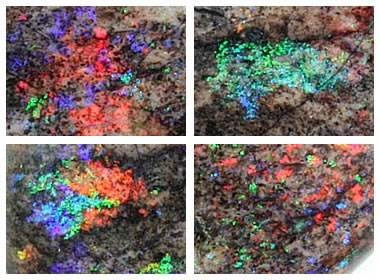
Andamooka Magnification: The photograph above shows several small areas of the Andamooka matrix opal cabochon shown at the top of this page, viewed under a microscope. It shows, in better detail, how patches of precious opal are in intimate association with the texture of the host rock. The width of the field of each view is about 1.5 millimeters.

Spectacular Color in Matrix Opal: The cabochon above is another example of treated Andamooka matrix opal. It shows spectacular patches of vivid blue, yellow, red, orange and green color. The photo is a Creative Commons image by Dpulitzer.
Matrix Opal in Limestone
Limestone is a soluble rock that can be replaced or silicified by the actions of underground waters. Precious opal can form in tiny voids within the limestone. It can also form as groundwater dissolves some of the limestone, and immediately precious opal precipitates in its place. This chemical process is known as "replacement" or "silicification".
One of the best-known examples of matrix opal in limestone is the Andamooka area of South Australia. Much of the matrix opal there occurs as small patches of host rock replacement within a light-colored limestone.
To provide greater color contrast, opal cutters often darken the host rock by treatment with smoke, burnt sugar solutions, or dye. The result is a dark matrix of black, dark gray, or brown which provides a contrasting background to the flashes of precious opal that are distributed through the rock. The beauty of a nice piece of Andamooka surprises many people when they see it for the first time.
When Andamooka or any other matrix opal has been darkened or colored by treatment, it should be labeled as "treated matrix" opal when offered for sale. Many people believe that it should not be called "Type 3 Opal" because of this treatment.
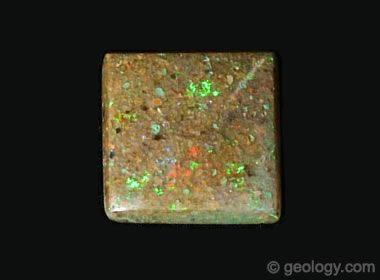
Louisiana Matrix Opal in Sandstone: If you look closely at this cabochon, you will see rounded sand grains with some of their interstitial spaces filled with precious opal. The cabochon was cut from a small slice of the Catahoula Formation found near Leesville, Vernon Parish, Louisiana.
Matrix Opal in Sandstone
Occasionally matrix opal will form in a porous sandstone. The opal precipitates in the interstitial pore spaces between the sand grains, forming a "cement" that binds the rock together. An example of matrix opal in sandstone is "Louisiana Opal", which is found in the Catahoula Formation near Leesville, Vernon Parish, Louisiana.
This material started out millions of years ago as loose sand grains deposited as a sediment. Then, groundwater moving through the sediment delivered small amounts of dissolved silica that, over time, precipitated as precious opal between the sand grains.
People found this sandstone and were surprised by the play-of-color in the rock matrix. A clever person decided to cut it into cabochons for use as a gem. A very limited amount of this material was found and mined. Today it is almost impossible to obtain.

Honduras Black Opal: The cabochon shown above is an example of basalt matrix opal from Honduras. The basalt contains tiny vesicles and cavities that are filled with precious opal. The black color of the basalt makes the play-of-color more obvious. Cabochon and photo by Stony Mountain Studio.
Honduras Black Opal
An example of matrix opal in basalt host rock is found in Honduras. There, a sequence of stacked basalt flows have extremely small vesicles and other pore spaces that are often filled with precious opal. The precious opal contrasts beautifully with the black basalt matrix to produce a pinfire pattern.
These deposits, near the community of Erandique, were mined at dozens of locations long before commercial opal mining occurred in Australia. Basalt matrix opal is still found in this part of Honduras, but production has always been limited. Boulder opal in rhyolite and andesite host rocks can also be found in this area.
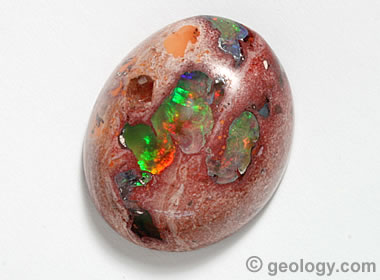
Precious Cantera Opal: This rhyolite cabochon displays several patches of precious and fire opal. It measures 24 x 20 millimeters.
Mexico's Cantera Opal in Rhyolite
Another material that many people call "matrix opal" is the cantera opal of Mexico. Cantera opal is a fire opal or precious opal that occurs in a pink to tan rhyolite matrix. Cutters often create cabochons of rhyolite that display colorful patches of fire opal or precious opal within them. The opal is often transparent, and some specimens have a fire opal bodycolor with flashes of precious opal within.

Cantera Fire Opal: Two cabochons of pink rhyolite, each containing a bright orangy red patch of fire opal. In Mexico, this opal is known as "cantera" but many consider it to be a matrix opal. The larger cabochon is about two centimeters across.
| More Gemstones |
 |
Tourmaline |
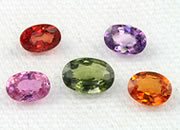 |
Fancy Sapphires |
 |
Diamond |
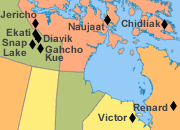 |
Canadian Diamond Mines |
 |
Birthstones |
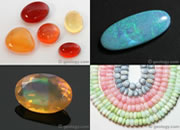 |
Pictures of Opal |
 |
Fire Agate |
 |
Blue Gemstones |

Find Other Topics on Geology.com:

|

| ||

|

| ||

|

| ||

|

|
